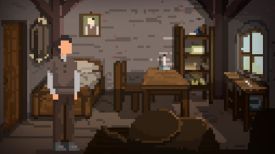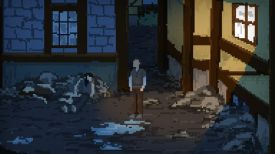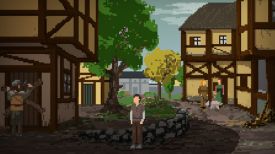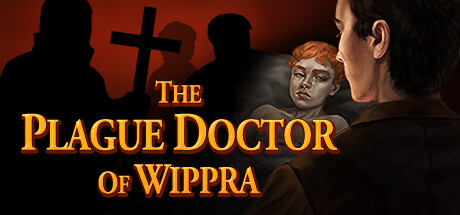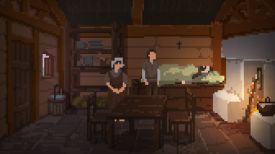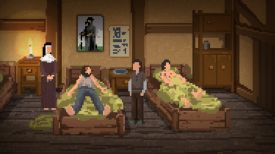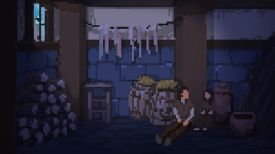The Plague Doctor of Wippra
Application Systems
Heidelberg
Another pixel art game, this
time very low res, The Plague Doctor of Wippra is a short but rather
thoughtful piece of adventuring.
You are Oswald Keller, recently
arrived physician in the plague riddled medieval town of Wippra. As a
doctor at the convent hospital you seek to understand and heal but
ignorance, superstition, and religious zeal is all around. It’s a
dangerous world, and it will stand you in good stead to remember that as
you do your best to treat the sick.
The humble appearance of the
game belies what lies within. Whilst it is a traditional inventory
driven point-and-click adventure, it delivers an interesting insight
into the plague doctor’s world. I thought it covered both the
methodologies of the doctor and the environment in which it had to be
practiced particularly well, allowing for the fact that I wasn’t there.
By which I mean that I have no idea what a plague doctor actually did,
but I can readily buy into it being something like this. Leeches, blood
letting and a well placed gilder, not to mention the vinegar rubs to
deal with fleas, all under the suspicious gaze of almost everyone.
Consistent with that aspect,
choices apparently matter. The game promises multiple endings and so I
might gotten a different one based on some of my decisions along the
way. Reflecting on things after the event, there might well be decisions
which are more about you than they are about your patients, should you
want a ‘better’ ending. Another nice nuance.
Apart from a puzzle or two, the
conundrums are predominantly inventory based, and as is typical of such
games you will try some things with every other thing at times. Or
perhaps that is just me. Looking at things is essential, and will often
generate an action hotspot or result in an item becoming accessible or
available. I thought once or twice it was a little clunky (things just
appearing where they weren’t before), but it was a small thing, and
people leave stuff lying about all the time.
The game utilises about the
middle two-thirds of my widescreen monitor, the inventory ribbon
occupying the bottom portion. Click to move around the world, and while
Oswald won’t run, double clicking will jump you to an exit. Some screens
scroll left and right, others are limited to what you see. You can left
or right click hotspots to interact, whichever you prefer, as the
hotspot will behave the same way regardless. However right clicking an
inventory item will describe it, while left clicking will select it for
using in the game world or with another inventory item. If where you
propose to use it in the game world is correct, the item will be
surrounded by a yellow outline.
With respect to inventory items,
I did find one occasion where using item A on item B didn’t work, but
doing it the other way around did. That single instance wasn’t a big
deal, and made a degree of conceptual sense given what I was trying to
do, but whether it might occur more often I don’t know.
Hotspots might generate a number
of cursers, but only one at a time. For instance when you first find
something you might be able to look at it, after which you might then be
able to take it or interact with it in some other way. You don’t ever
choose which curser to select, other than through your earlier actions.
A speech bubble curser indicates
you can talk to the character concerned and while much of it is about
gathering detail and moving the story forward, some dialogue choices
might well impact the ending. It is all read, there being no spoken
voice, with ambient sounds and an intermittent soundtrack providing the
‘noise.’ It all came together well, and each did its bit in contributing
to the whole.
The game saves when you exit,
and you choose continue when you next play. There is no saving at will
but it isn’t needed. You can tweak a few settings, including whether to
play with the space bar indicating the hotspots. I had it turned on, and
while the game isn’t hard, on occasion I found it helpful. The hotspots
were fairly generous which compensates for some of the fine detail
missing in the pixelly environment.
I confess to being pleasantly
surprised by the almost three hours I spent as Oswald. Despite its
modest visage, it provided an interesting and enjoyable window onto its
subject matter. So much so that I will certainly be playing again in an
effort to find that better outcome.
I played on:
OS: Windows 10, 64 Bit
Processor: Intel i7-9700K 3.7GHz
RAM: Corsair Dominator Platinum RGB DDR4 32GB
Video card: AMD Radeon RX 580 8192MB
GameBoomers Review Guidelines
October 2022
design copyright© 2022
GameBoomers
Group
